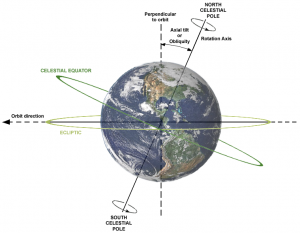
BY HANNES THUM

It is a common misconception that we have seasons on this planet because the distance from the Earth to the sun varies throughout the year. The distance between us and the sun does indeed change throughout the year (our solar orbit is not a perfect circle), but that is not the reason for the seasons.
The seasons we experience throughout the year, from the dark cold of winter to the hot and hazy days of summer, are a result of the fact that the Earth has a wobbly tilt to it; Earth spins on an axis that has lurched to the side—at around 23.4 degrees, to be precise. Our annual lap around the solar system takes us through different geometric arrangements: in winter, the Northern Hemisphere is tilted away from the sun; in summer, it’s tilted toward the sun.
In his book My Story as Told by Water, in a chapter titled “Tilt,” David James Duncan described the situation thusly: “…like a long-ago-injured woman who’s learned to walk gracefully with a cane, Earth leans ever so slightly on her axis, inclining now toward the sun, now away from it as she orbits, thereby causing the angle at which sunlight strikes her to change constantly.”
Right now, we are going through the transition between winter and summer. The sun is climbing higher each day as we head toward the summer solstice, as the alignment between us and it means that it appears more directly overhead each day.
The latitude of our valley is around 43.5 degrees north. But, the tilt of things means that as we head into the summer, our effective solar angle becomes more southerly: on the summer solstice (June 21 this year), we will have the same solar angle and the same length of day that is usually associated with the latitude of the Big Island of Hawaii, of the Yucatan Peninsula, of a Caribbean island.
As Duncan watched the seasons change in his backyard in Montana, he continued: “I realized that, as surely as I have ever journeyed by boat, car, or plane, I had been carried into a foreign country. The entire Earth had been my vessel.”
And so (in this way of thinking about it) our valley, our ship of sorts, is moving currently southward and toward the equator and the sun, leaving behind the winterbound locales and sailing daily toward summer, longer days, warmer weather. We’re thawing out as we head into sunnier places, the hull of the ship shedding snow and ice and frost as we go along, the people aboard it gradually shedding layers of clothing and stowing them away.
We are southbound travelers, our ship’s prow cutting surely toward the sun each day, taking us into summer. Eventually, our ship will round a corner and head back north and take us back into winter, thus completing our annual circuit of the seasons. We are migrators, of a sort, whether we realize it or not.
Hannes Thum is a Wood River Valley native and has spent most of his life exploring what our local ecosystems have to offer. He currently teaches science at Sun Valley Community School.
